Boldly Committed to Truth Telling in the False Face of Fakery
John Lawson (1674-1711)
Publisher's note: We believe the subject of history makes people (i.e., American people) smarter, so in our quest to educate others, we will provide excerpts from the North Carolina History Project, an online publication of the John Locke Foundation. This fifty-eighth installment was originally posted in the North Carolina History Project.
On December 28, 1700, Lawson -- with a party of five Englishmen and various Indian guides picked up along the way -- set out on a brave journey through the wastes of Carolina. Following the Santee and Wateree Rivers through southern Carolina, Lawson's party met with members of several Native American tribes in the region, including the Santee, Congaree, Wateree, and Waxhaw Indians.
In late January 1701, the Lawson expedition crossed into what is now North Carolina in the neighbohood of present-day Charlotte. More tribes were encountered -- including the "Esaws," Sugaree, and Catawba Indians -- and the explorers resumed their journey along the famous Trading Path. This trade route stretched north and eastward through the interior of the province.
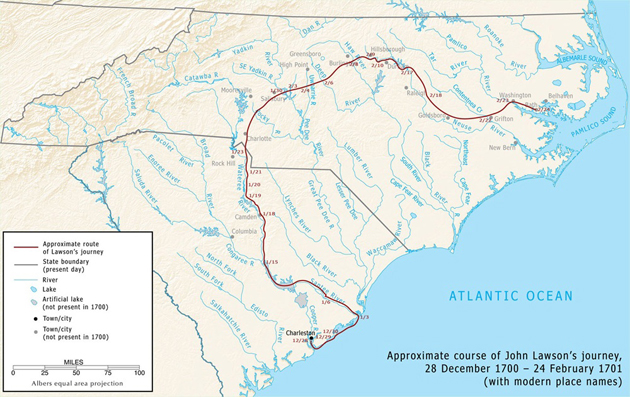
A route map of the early 18th century exploration of John Lawson throughout the Carolinas: Above. Click Click the picture to expand to as much as 1000 pixels wide within most expanded images, and then push the arrows embedded in the center edge of the play-box to access the gallery, and slide new images into viewing within the center of the screen.
The group crossed the Uwharrie River on February 5, and came to the village of Keyauwee Town. Three days later most of Lawson's party decided to travel straight to Virginia from Keyauwee Town. Lawson and a companion, however, resolved to continue their trek through Carolina.
The route eastward from Keyauwee Town led Lawson across a tangle of creeks and rivers to Occaneechi Town, near present-day Hillsborough. At Occaneechi, Lawson picked up a trusted Indian named Enoe Will, who agreed to guide the explorer to the English settlements along the coast.
With Enoe Will and several other Indians, Lawson's group left the Trading Path, crossed the Eno River at Ocanneechi Town, proceeded to the village of Adshusheer (near present-day Durham), and crossed the falls of the Neuse River on February 18. Two days later they reached the "hunting quarter" of 500 Tuscarora Indians.
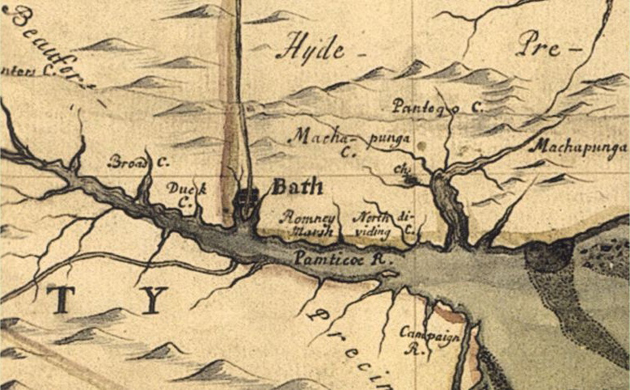
Old Map of Beaufort County, North Carolina back in John Lawson's Day: Above.
Aided by several of these Indians, the party made its way through the densely settled Tuscarora country. They passed near the present site of Goldsboro, crossed Contentnea Creek near present-day Grifton, and crossed the Tar River at what is now Greenville. Finally, on February 23, 1700, the explorers reached the English settlements on the "Pampticough" River, in the vicinity of what is now Washington, North Carolina. Lawson's excursion came to an end at the Pamlico River, at the plantation of a man named Richard Smith.
In the dead of winter, guided solely by Native Americans, the expedition had lasted 59 days and covered some 550 miles through the forbidding Carolina backcountry. And the curious Lawson, with a keen eye for detail, recorded a wealth of information along the way.
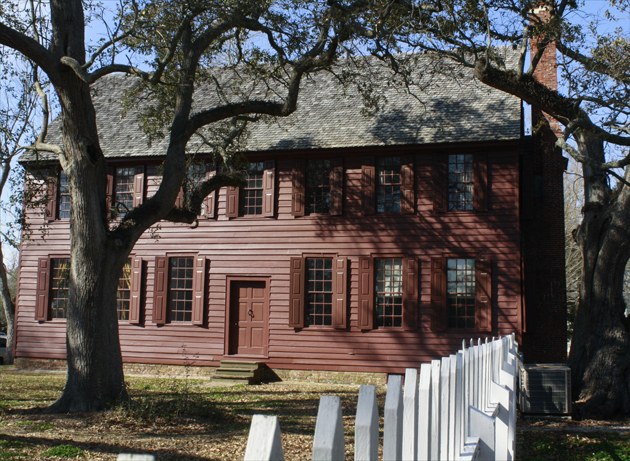
The Palmer-Marsh House in today's Bath, North Carolina: Above.
St. Thomas Episcopal Church in March, 2013: Below. photos by Stan Deatherage Click the picture to expand to as much as 1000 pixels wide within most expanded images, and then push the arrows embedded in the center edge of the play-box to access the gallery, and slide new images into viewing within the center of the screen.
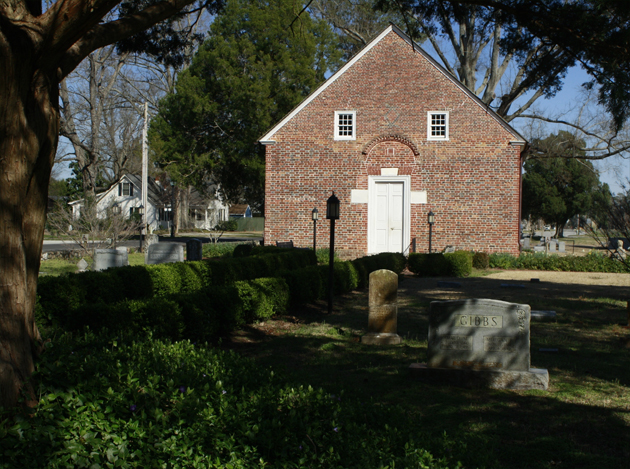
Soon after settling in the Pamlico region, Lawson built himself a house near the Indian town of Chatooka -- future site of the town of New Bern. The adventurer noted that his home "stood on a pretty high Land and by a creek-side," a stream that is now known as Lawson's Creek.
Within a few years of arriving in Carolina, John Lawson acquired a tract of land in the Pamlico region along the banks of Old Town Creek (now known as Bath Creek).
Bath County had been established in 1696, and its large landowners included Joel Martin, Simon Alderson, Nicholas Daw, and David Perkins. Sometime around 1704 or 1705, Perkins transferred about 60 acres of his property to Lawson, Martin, and Alderson.
The Town of Bath was established by an act of the General Assembly on March 8, 1705 -- thus becoming North Carolina's first incorporated town. Lawson, Martin, and Nicholas Daw were the village's first commissioners.
The first recorded sale of lots in Bath was on September 26, 1706 -- and John Lawson was one of the purchasers. Lawson's layout of the town called for 71 lots, each of which contained one acre and four poles. Lawson bought two lots at the tip of the peninsula, and made his home in Bath.
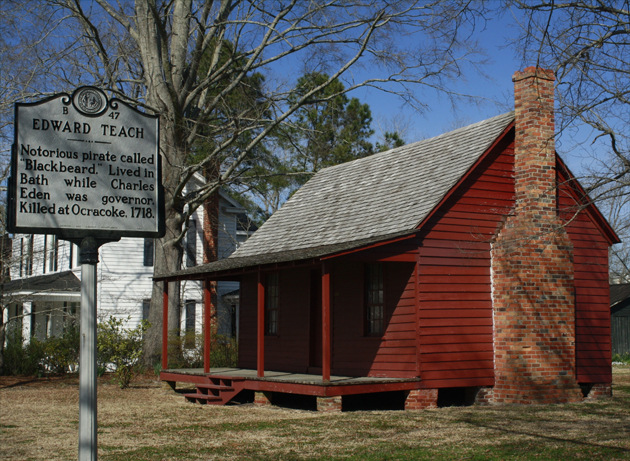
The former residence of one Edward Teach, "Blackbeard," in Bath, North Carolina: Above. The Bonner House at Bath Point overlooking Bath Creek: Below. photos by Stan Deatherage Click the picture to expand to as much as 1000 pixels wide within most expanded images, and then push the arrows embedded in the center edge of the play-box to access the gallery, and slide new images into viewing within the center of the screen.

Lawson was active in Bath's political and economic life and that of the county. From January 1706/7 to August 1708, he served as clerk of court and public register of "Pampticough Precinct."
In 1707, Lawson, Chief Justice Christopher Gale, and Dr. Maurice Luellyn erected a "horse-mill" in Bath. The agreement between these men -- three of Bath's most prominent citizens -- stipulated that "no owner would grind any grain but what was properly for his own family's use nor grant permission for anyone else to grind their grain at the mill without the consent of the owners."
A gentleman by birth, John Lawson was a well educated man. During his long journey through Carolina, Lawson had kept an extensive journal. In addition to recording detailed notes on the varied and abundant flora and fauna of the region, he also started a small vocabulary of Native American language.
Though Lawson claimed that his reason for coming to America involved a desire to travel, there is good reason to believe that he may have been urged or hired to make the trip by James Petiver. Petiver was a London apothecary and the greatest collector of botanical specimens of his era. The two corresponded frequently, and Petiver claimed that Lawson was "the most knowledgeable" of the apothecary's correspondents in America. And the volume of data collected by Lawson was thorough, indeed.
Lawson also engaged in surveying work, and soon became the deputy of Edward Moseley, the province's surveyor-general. He would eventually succeed Moseley in the post.
Early in 1709, Lawson sailed back to England to oversee the publication of his book, A New Voyage to Carolina. The provincial historian had assembled his notes and observations into a comprehensive narrative. The massive work contained an introduction, Lawson's journal entries, a general description of North Carolina, notes on the present state of the colony, the natural history of Carolina, and detailed observations on North Carolina's Native American population. This monumental "history" was the only book to come out of proprietary North Carolina. It is one of the most valuable early volumes on North Carolina, and is one of the best travel accounts of the early eighteenth-century American colonies.
In July 1709, the Lords Proprietors appointed Lawson and Edward Moseley as commissioners for North Carolina's interests in the long-running border dispute with the colony of Virginia. (When the final line was run in 1728, it was very close to Lawson's observations).
For most of the decade that Lawson lived in North Carolina, the colony was in political turmoil and confusion. Efforts to establish the Church of England and legal discriminations against Quakers and other "dissenters" caused tension that soon reached a boiling point. The conflict spawned "Cary's Rebellion" in 1710, but Lawson managed to steer clear of political controversy during this time.
With Christopher Von Graffenried, Lawson also co-founded the town that became known as New Bern. He persuaded Graffenried, leader of the Swiss and Palatine colonists at New Bern, and Christopher Gale, receiver-general of the colony (his friend and neighbor at Bath), to accompany him on an exploring trip up the Neuse River. Gale, however, did not accompany the party because his wife and brother were sick with yellow fever.
While Graffenried eventually returned from this expedition, John Lawson did not. The party fell into trouble with the powerful Tuscarora Indians, and Lawson was savagely executed. Thus the famous explorer became the first casualty in a terrible war, as the disgruntled Native Americans sought revenge against injustices brought by white settlers.
Sources:
Entry originally published at http://www.nchistoricsites.org/bath/lawson.htm, Reposted here with permission from NC Historic Sites
Go Back
On December 28, 1700, Lawson -- with a party of five Englishmen and various Indian guides picked up along the way -- set out on a brave journey through the wastes of Carolina. Following the Santee and Wateree Rivers through southern Carolina, Lawson's party met with members of several Native American tribes in the region, including the Santee, Congaree, Wateree, and Waxhaw Indians.
In late January 1701, the Lawson expedition crossed into what is now North Carolina in the neighbohood of present-day Charlotte. More tribes were encountered -- including the "Esaws," Sugaree, and Catawba Indians -- and the explorers resumed their journey along the famous Trading Path. This trade route stretched north and eastward through the interior of the province.

The group crossed the Uwharrie River on February 5, and came to the village of Keyauwee Town. Three days later most of Lawson's party decided to travel straight to Virginia from Keyauwee Town. Lawson and a companion, however, resolved to continue their trek through Carolina.
The route eastward from Keyauwee Town led Lawson across a tangle of creeks and rivers to Occaneechi Town, near present-day Hillsborough. At Occaneechi, Lawson picked up a trusted Indian named Enoe Will, who agreed to guide the explorer to the English settlements along the coast.
With Enoe Will and several other Indians, Lawson's group left the Trading Path, crossed the Eno River at Ocanneechi Town, proceeded to the village of Adshusheer (near present-day Durham), and crossed the falls of the Neuse River on February 18. Two days later they reached the "hunting quarter" of 500 Tuscarora Indians.

Aided by several of these Indians, the party made its way through the densely settled Tuscarora country. They passed near the present site of Goldsboro, crossed Contentnea Creek near present-day Grifton, and crossed the Tar River at what is now Greenville. Finally, on February 23, 1700, the explorers reached the English settlements on the "Pampticough" River, in the vicinity of what is now Washington, North Carolina. Lawson's excursion came to an end at the Pamlico River, at the plantation of a man named Richard Smith.
In the dead of winter, guided solely by Native Americans, the expedition had lasted 59 days and covered some 550 miles through the forbidding Carolina backcountry. And the curious Lawson, with a keen eye for detail, recorded a wealth of information along the way.


Soon after settling in the Pamlico region, Lawson built himself a house near the Indian town of Chatooka -- future site of the town of New Bern. The adventurer noted that his home "stood on a pretty high Land and by a creek-side," a stream that is now known as Lawson's Creek.
Within a few years of arriving in Carolina, John Lawson acquired a tract of land in the Pamlico region along the banks of Old Town Creek (now known as Bath Creek).
Bath County had been established in 1696, and its large landowners included Joel Martin, Simon Alderson, Nicholas Daw, and David Perkins. Sometime around 1704 or 1705, Perkins transferred about 60 acres of his property to Lawson, Martin, and Alderson.
The Town of Bath was established by an act of the General Assembly on March 8, 1705 -- thus becoming North Carolina's first incorporated town. Lawson, Martin, and Nicholas Daw were the village's first commissioners.
The first recorded sale of lots in Bath was on September 26, 1706 -- and John Lawson was one of the purchasers. Lawson's layout of the town called for 71 lots, each of which contained one acre and four poles. Lawson bought two lots at the tip of the peninsula, and made his home in Bath.


Lawson was active in Bath's political and economic life and that of the county. From January 1706/7 to August 1708, he served as clerk of court and public register of "Pampticough Precinct."
In 1707, Lawson, Chief Justice Christopher Gale, and Dr. Maurice Luellyn erected a "horse-mill" in Bath. The agreement between these men -- three of Bath's most prominent citizens -- stipulated that "no owner would grind any grain but what was properly for his own family's use nor grant permission for anyone else to grind their grain at the mill without the consent of the owners."
A gentleman by birth, John Lawson was a well educated man. During his long journey through Carolina, Lawson had kept an extensive journal. In addition to recording detailed notes on the varied and abundant flora and fauna of the region, he also started a small vocabulary of Native American language.
Though Lawson claimed that his reason for coming to America involved a desire to travel, there is good reason to believe that he may have been urged or hired to make the trip by James Petiver. Petiver was a London apothecary and the greatest collector of botanical specimens of his era. The two corresponded frequently, and Petiver claimed that Lawson was "the most knowledgeable" of the apothecary's correspondents in America. And the volume of data collected by Lawson was thorough, indeed.
Lawson also engaged in surveying work, and soon became the deputy of Edward Moseley, the province's surveyor-general. He would eventually succeed Moseley in the post.
Early in 1709, Lawson sailed back to England to oversee the publication of his book, A New Voyage to Carolina. The provincial historian had assembled his notes and observations into a comprehensive narrative. The massive work contained an introduction, Lawson's journal entries, a general description of North Carolina, notes on the present state of the colony, the natural history of Carolina, and detailed observations on North Carolina's Native American population. This monumental "history" was the only book to come out of proprietary North Carolina. It is one of the most valuable early volumes on North Carolina, and is one of the best travel accounts of the early eighteenth-century American colonies.
In July 1709, the Lords Proprietors appointed Lawson and Edward Moseley as commissioners for North Carolina's interests in the long-running border dispute with the colony of Virginia. (When the final line was run in 1728, it was very close to Lawson's observations).
For most of the decade that Lawson lived in North Carolina, the colony was in political turmoil and confusion. Efforts to establish the Church of England and legal discriminations against Quakers and other "dissenters" caused tension that soon reached a boiling point. The conflict spawned "Cary's Rebellion" in 1710, but Lawson managed to steer clear of political controversy during this time.
With Christopher Von Graffenried, Lawson also co-founded the town that became known as New Bern. He persuaded Graffenried, leader of the Swiss and Palatine colonists at New Bern, and Christopher Gale, receiver-general of the colony (his friend and neighbor at Bath), to accompany him on an exploring trip up the Neuse River. Gale, however, did not accompany the party because his wife and brother were sick with yellow fever.
While Graffenried eventually returned from this expedition, John Lawson did not. The party fell into trouble with the powerful Tuscarora Indians, and Lawson was savagely executed. Thus the famous explorer became the first casualty in a terrible war, as the disgruntled Native Americans sought revenge against injustices brought by white settlers.
Sources:
Entry originally published at http://www.nchistoricsites.org/bath/lawson.htm, Reposted here with permission from NC Historic Sites





















